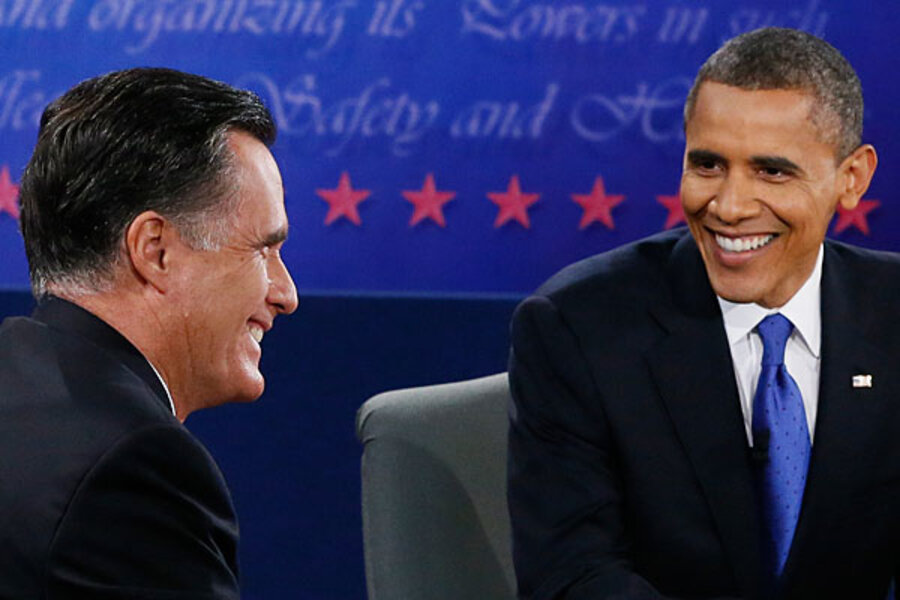Presidential debate 101: Does Romney have 'economic policies of the 1920s'?
Loading...
President Obama took one of his rhetorical thrusts at Mitt Romney to new heights, or depths, in their debate Monday, asserting that his rival wants to revive the "economic policies of the 1920s."
Throughout the presidential race, Mr. Obama has adopted the slogan "Forward" for his own policies, and charged that his Republican challenger wants to reinstate failed policies of the past that "got us into this mess."
The comments typically imply that Romney is a clone of President Bush. On Monday, Obama's remark looked some eight decades further back, to the White House administrations of other low-tax Republicans: Warren Harding and Calvin Coolidge.
But what, exactly, was Obama alleging, and is it true? The quick answer is: It depends on what Obama meant.
The zinger came at the end of a string of other accusations, and Obama offered no further elaboration on it, leaving it unclear exactly what he was suggesting.
But the most obvious parallel between Republican leaders in the 1920s and Mr. Romney is the theme of low taxes and light regulation. Obama's implication is probably that things didn't work out so well then, with the Wall Street crash and the Great Depression starting at the end of the decade under another Republican, Herbert Hoover (inaugurated in 1929). So we might not want to elect someone advocating the same path now.
Yet if that is what Obama was saying, the allegation is problematic. Many economic historians suggest that those policies did not set the stage for the Great Depression. Rather, the economists point largely to a different factor: harmful monetary conditions. In short, the Federal Reserve's tight rein on money was a precipitating factor, which then interacted with other problems (including bank runs and a poor fiscal response to the downturn) that worsened the economy.
Now, if Obama was making that more nuanced point, he might be on firmer ground. He could argue that Romney as president would use his power of appointment to steer the Federal Reserve in a direction of tight monetary policy – repeating mistakes seen in the 1920s and 1930s.
For example, most economists who do forecasting for the nation's businesses support the Fed's current policy of "quantitative easing" – purchasing US bonds in an attempt to lower their value and encourage investors to invest their money elsewhere, boosting the private-sector economy. But Romney has said that he's not a fan of quantitative easing. And he has said he would not reappoint Ben Bernanke as Fed chairman when Mr. Bernanke's term expires in 2014.
But is Romney really a throwback to Harding, Coolidge, and Hoover?
Certainly, there are some parallels. At the beginning of the '20s, the decade certainly wasn't roaring. When Harding was elected in 1920, the nation was in deep economic trouble prompted by the end of World War I. Federal spending had plunged, consumer prices were deflated, and unemployment was high. Harding called for a "return to normalcy."
The economy began to improve even before Harding's tax cuts came into effect. Some historians credit falling tax rates with improving the economy in the next few years, with unemployment falling from nearly 9 percent to about 5 percent by 1923. After Harding died in office, Coolidge took over with a philosophy that emphasized states rights and minimal federal regulation. "The chief business of the American people is business," he famously declared.
After the US had operated with high deficits during the war, Republicans held spending down to run budget surpluses and bring down the national debt.
Today's tax narrative, however, is quite different from that of the 1920s. By the end of World War I, for example, the highest income tax rate was 77 percent; today it is 35 percent.
Moreover, while both presidential candidates today talk of reining in federal budgets, no one considers surpluses remotely likely in the near term. Yes, Romney has positioned himself closer to the Harding-Coolidge policy model than Obama has, by espousing low taxes and regulation. But his proposal to cap federal spending 20 percent of the nation's gross domestic product (GDP) would sound profligate to "Silent Cal."
By the time Hoover took over from Coolidge in 1929, federal spending ran about 3 percent of GDP.
Yet simply bringing deficits down would be an achievement today. In part, that's because many economists warn against too-rapid efforts at fiscal reform, saying it could drag down economic growth in the short run. (That's what today's "fiscal cliff" debate, revolving especially around expiring tax cuts, is about.) In addition, despite the political rhetoric, no one is advocating an end to entitlements like Medicare, but rather ways to reform them.
Beyond these more obvious interpretations of Obama's one-liner, there could be another resonance, intended or not.
The Harding administration became known as a haven of corruption, which spilled over into the private sector in incidents such as the Teapot Dome scandal. The scandal involved bribes paid to the Interior secretary in return for a sweetheart oil-lease deal. Obama has called out Romney as having ties to Wall Street and to corporations that outsource jobs overseas, and deregulation is broadly seen by critics as turning the keys of government over to business.
On this point, though, Romney could hit back. He has complained about Washington's ties to corporate cronies – citing Obama's banking reforms and his deals to fund green-energy firms as cases in point.
So, in the end, was Obama suggesting that Romney policies would set the US up for another epic crash? It seems so, and certainly the 1920s ended badly. But business cycles have happened, with greater or lesser degrees of severity, whether tax rates or deficits in the US have been high or low. If anything, the 1920s may stand as a warning for the next president not to be complacent, whether that person is named Obama or Romney.






